Game Design To Reload Or Not
I've been studying game design for a while and, every now and then, I get obsessed by the role one single mechanic play in a game system. This time, as we work on an action shooter I got quite deep in the tank about one of genre staples mechanics: Reloading.
The game is an old week long jam game Diego built years ago. It's a local multiplayer stealth action shooter. Player move in the dark, revealing themselves to shoot or due to environment lights (you can check the original here and our current prototype here). During the jam, he added bullets and reloading as a given. It's a shooter after all.
After building original's feature set, we started a feature brainstorm that lead to the question: "Why do we need reload?". I usually try to evaluate game mechanics as needs and wants. Do I, as a game developer, want the feature in my game cause I think it's awesome or does the game need it to be fun/work. Trying to be aware of this usually helps me challenge assumptions made by others or even by past me and, hopefully, build to better games.
The Research
Reloading is quite a common mechanic, so, I had plenty of content to consume and many implementations to understand. A feeling I had from the beginning was that Reloading is one of those solid/convergent mechanics. It has been around for a long time and there isn't much innovation around it in recent games. I read this as a good thing as it usually means the mechanic is stable and play an important role in games it appear.
Below, I tried to compile the most relevant and interesting spawns of Reloading I found, focusing more on design. There is plenty variety on the animation side of reloading too, but it matter less to my goals with this research. That said, this list don't even pretend to be exhaustive.
The Plain Reload
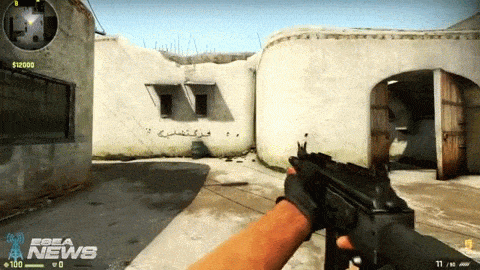
This is the most common implementation and great place to start. Player hit a button to refill weapon's bullet clip or it force refill once the gun is out of ammo. So, what does this achieve?
It exchange a vulnerability period (aka. can't shoot) now for battle readiness (aka. a full clip) later, rewarding players that pay attention to their bullet count (sometimes to enemies counts too) and, more importantly, limiting encounter duration. This was the key insight of this research for me. The bullet limit and reloading mechanic gives every shoot exchange a clear time limit as player will either die or have to flee and reload.
This, plus the veracity of the mechanic goes a long way in explaining why this appears in most shooters. Every encounter is full of small meaningful decisions as players are always looking for the right time to stop and reload giving up as little room for enemies to exploit as possible.
The No Reload
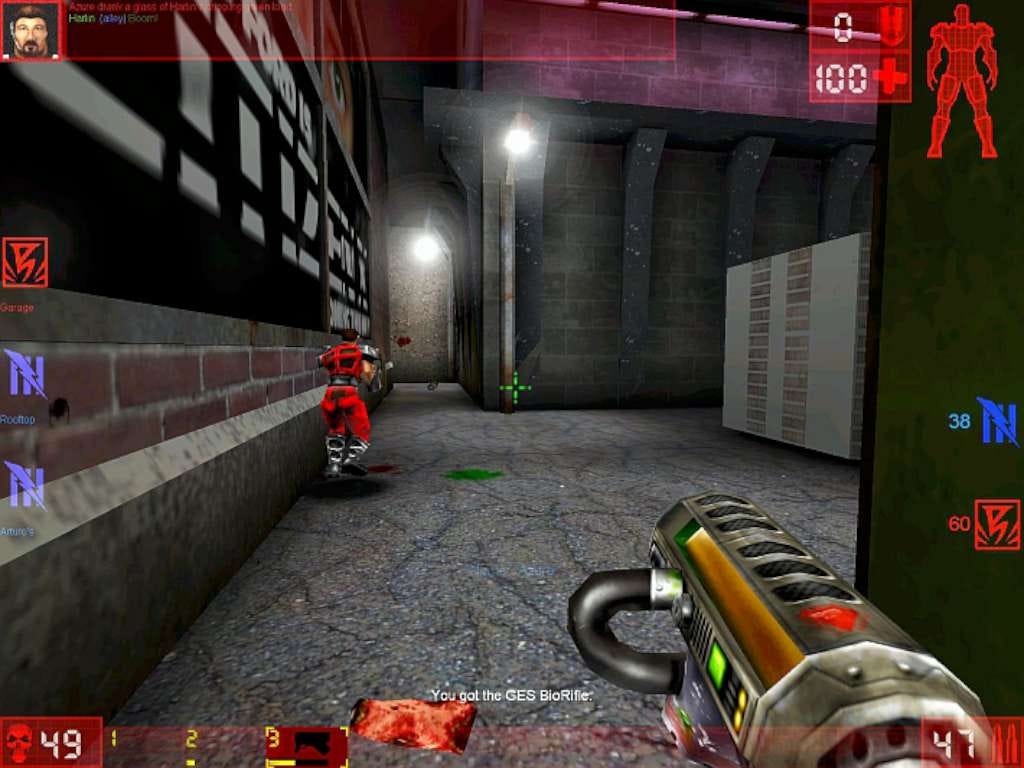
Let's bounce right back.
Unreal Tournament was a game I played A LOT in my teenage years. Interestingly, it does not have any reloading mechanic. It still has bullet limits but those are not as big of a constraint, especially since players can carry many guns and ammo is plenty. Players just keep going through loaded guns and shooting close to non-stop.
We can see that this helps setting the "balls to the wall" shooting style the franchise is famous for. Players have less strategic decisions and focus more on mechanical shooting.
The Heat Gun
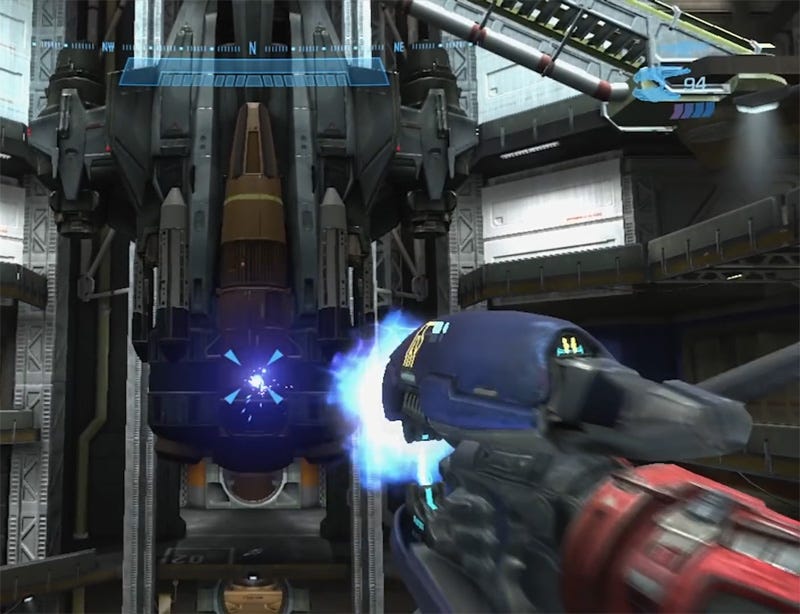
This is another quite common spawn of reloading, specially in sci-fi games. It's all about the fire rate. There is no bullets limits or reloading time but if the player shoots too much in a window of time the weapon overheats, leading to a vulnerability period while it cools off.
This has the same effect as basic reloading on encounter duration but rewards a different play style. Players have less interesting decisions at the start of an encounter and more as the firing goes on. It also makes it harder for a player to "control" enemy bullet count and act around it.
The Refilling
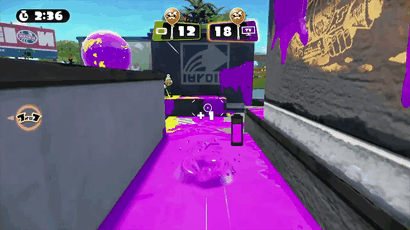
Splatoon has such an innovative spawn of Reloading that it even has it's own name: Refilling. Nintendo will Nintendo, right?
To reload a weapon in this game, a player has to move around inside ink (created by shooting) as a squid, with increased move speed, forcing players to alternate between shooting and moving constantly. To be honest, I find this one brilliant, as it couples shooting and moving in a very elegant way. As I said, Nintendo will Nintendo, right?
Another interesting point of view, is that this probably helps with the learning curve too (never played to confirm) as alternating between moving and shooting is commonly the "right" way to play shooters and not super intuitive to newcomers. Now, when it comes to encounter duration, I think it has a very similar result as the Plain Reload.
The Active Reload
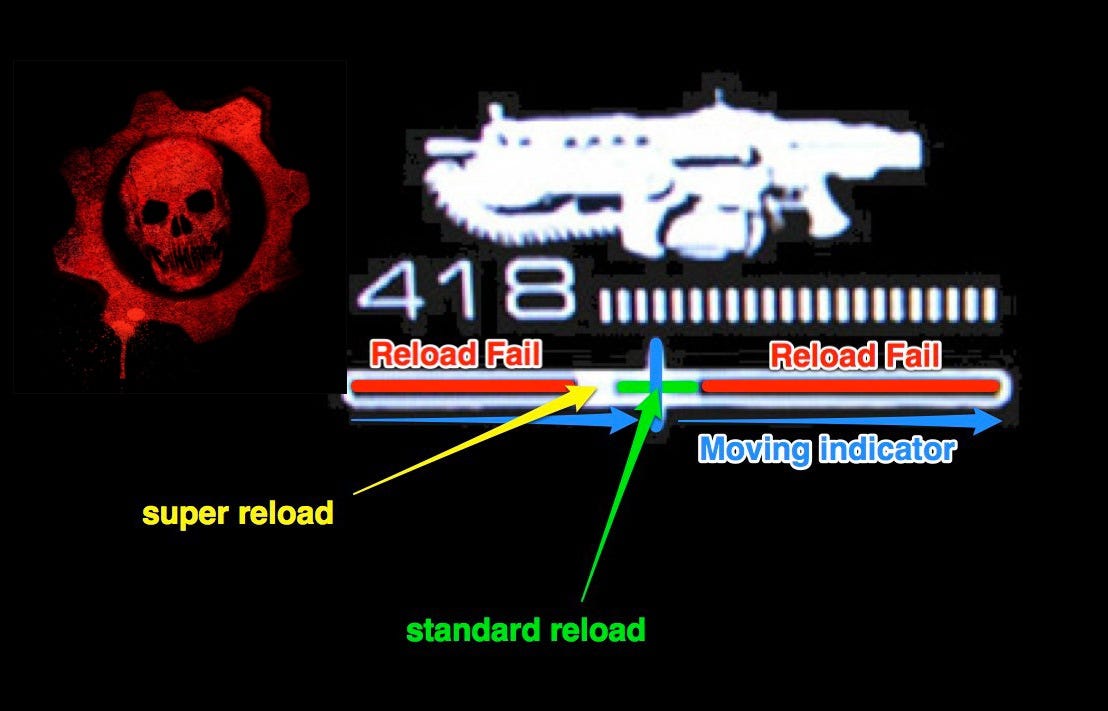
Another important innovation in this mechanic was Gears of War's Active Reload.
The idea here is to add another layer of skill as players can actually be good at reloading. It rewards players that hit a second button press mid reloading with a faster reload time and a damage boost (yes, I am as confused as anyone about the damage boost). This is a quite cool idea but you do ask a lot from the player if you ask them to do that mid firing. I guess it fits right in the cover based shooting Gears is famous for.
Honorable mentions
- Some games let you use the empty cartridge as an object in the world, for example: Metal Gear Solid let's you throw it around to lure guards.
- Reloading in a fighting game just because. In UNIEL/UNIST, Eltnun has bullet count and reloading.
- Receiver is also quite curious as players have different buttons for things like "remove cartridge" or "close revolver cylinder", turning reloading into a complex button sequence mid combat.
Game Design To Reload Or Not
Source: https://medium.com/rock-milk/what-is-the-role-of-reloading-as-a-game-mechanic-10f9e67ccc42
Posted by: youngbort1991.blogspot.com

0 Response to "Game Design To Reload Or Not"
Post a Comment